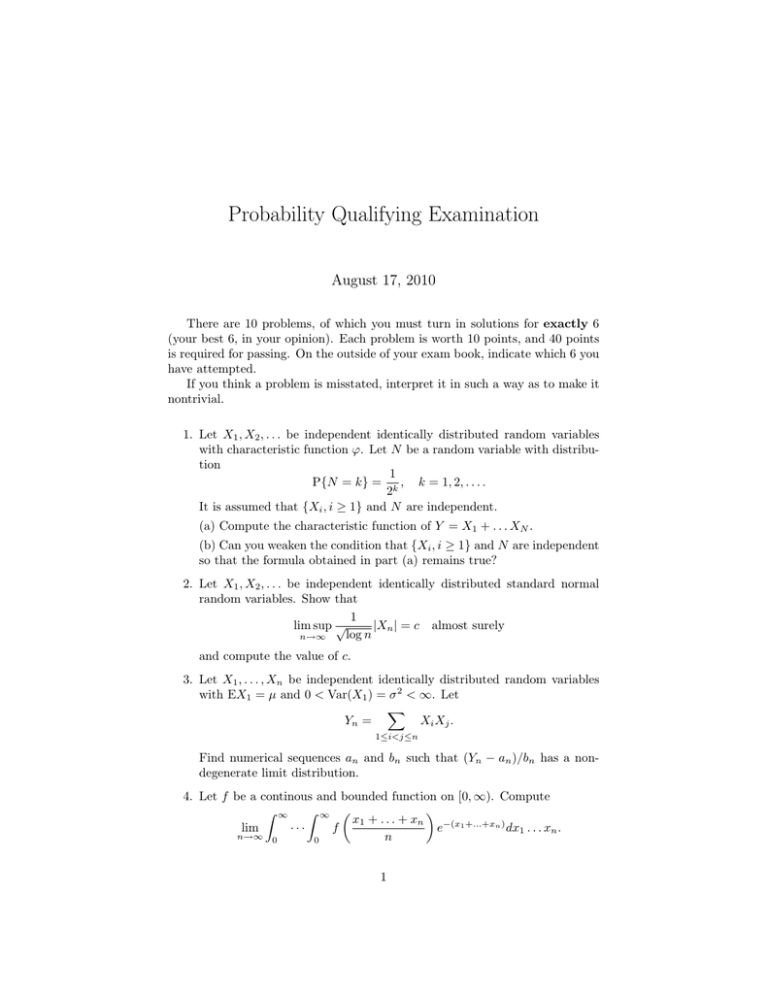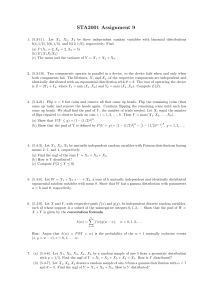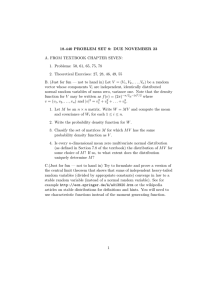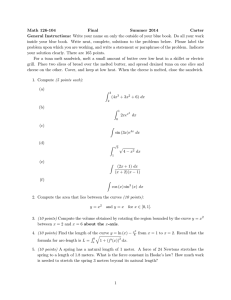Probability Qualifying Examination August 17, 2010
advertisement

Probability Qualifying Examination
August 17, 2010
There are 10 problems, of which you must turn in solutions for exactly 6
(your best 6, in your opinion). Each problem is worth 10 points, and 40 points
is required for passing. On the outside of your exam book, indicate which 6 you
have attempted.
If you think a problem is misstated, interpret it in such a way as to make it
nontrivial.
1. Let X1 , X2 , . . . be independent identically distributed random variables
with characteristic function ϕ. Let N be a random variable with distribution
1
P{N = k} = k , k = 1, 2, . . . .
2
It is assumed that {Xi , i ≥ 1} and N are independent.
(a) Compute the characteristic function of Y = X1 + . . . XN .
(b) Can you weaken the condition that {Xi , i ≥ 1} and N are independent
so that the formula obtained in part (a) remains true?
2. Let X1 , X2 , . . . be independent identically distributed standard normal
random variables. Show that
1
lim sup √
|Xn | = c almost surely
log n
n→∞
and compute the value of c.
3. Let X1 , . . . , Xn be independent identically distributed random variables
with EX1 = µ and 0 < Var(X1 ) = σ 2 < ∞. Let
!
Yn =
Xi Xj .
1≤i<j≤n
Find numerical sequences an and bn such that (Yn − an )/bn has a nondegenerate limit distribution.
4. Let f be a continous and bounded function on [0, ∞). Compute
$
" ∞
" ∞ #
x1 + . . . + xn
lim
···
f
e−(x1 +...+xn ) dx1 . . . xn .
n→∞ 0
n
0
1
5. Let X1 , . . . , Xn be independent identically distributed Poisson random
variables for each n with parameter λn .
(a) Show that X1 + . . . + Xn is asymptotically normal if and only if nλn →
∞.
(b) Can you weaken the condition that the X’s are identically distributed
for each n?
6. Let X be a random variable with characteristic function ϕ. Show that X
is symmetric if and only if ϕ(t) is real for all t.
7. Let X and Y be integrable random variables on (Ω, F, P ), and let G be a
sub-σ-algebra of F. If X = Y on G ∈ G, show that E[X | G] = E[Y | G]
a.s. on G.
8. Let Zn be a Galton–Watson branching process with offspring distribution
{pk , k %
= 0, 1, 2, . . .} and Z0 = x (with x a positive integer), and let
f (θ) =
pk θk be the associated pgf. Suppose that ρ ∈ (0, 1) satisfies
f (ρ) = ρ. Show that ρZn is a martingale, and use this to conclude that
P(Zn = 0 for some n ≥ 0) = ρx .
9. Let X ≥ 0, EX 2 < ∞, and 0 ≤ a < EX. Apply the Cauchy–Schwarz
inequality to prove that P(X > a) ≥ (EX − a)2 /EX 2 .
10. By considering the Poisson distribution, show that
#
$
n2
nn
1
−n
e
1+n+
+ ··· +
→
2!
n!
2
as n → ∞.
2






